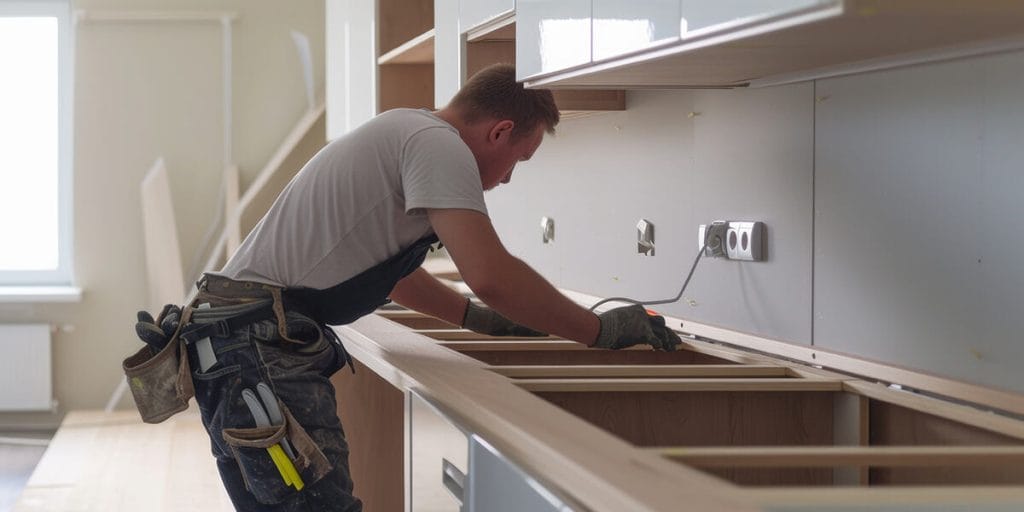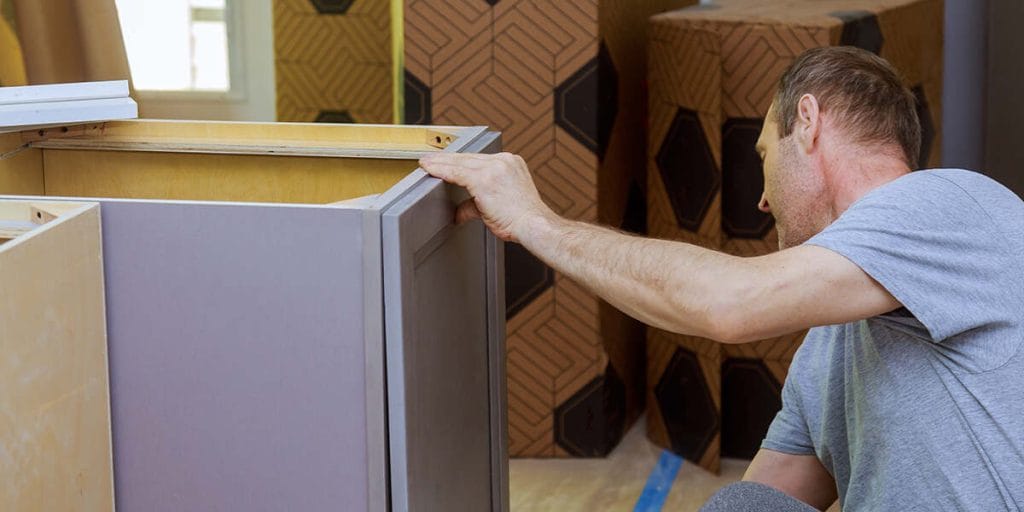Do You Need a Permit To Remodel Your Kitchen?

When making your house a home, sometimes you need to change the design or layout of a space or two. Tempted as you may be to start working immediately, you may have heard something about building permits. So, now you’re wondering, “Do I need a permit for a kitchen remodel on my property?” As one of the best companies for kitchen remodeling in Hollywood, FL, Viteri Cucine maintains updated information about building codes and what we need to start designing. With a permit, you may dodge legal troubles and start your kitchen remodel on the right foot. The Point of a Permit Building permits give those intending to work on a property the green light to build a new structure or add onto an existing one. The government agency reviews the plans for the renovation and ensures they meet state and local standards on various points: If the agency does not find the designs and renovations mindful of these points, along with local laws and construction ordinances, they will reject the permit application. Then, you would have to reapply with corrected plans until you present one that meets expectations. You can only legally start some renovations after the agency’s approval. When Is a Permit Required? “Do I need a permit for a kitchen remodel if I’m just painting the walls?” No, you generally don’t need a permit for residential wall painting. You could also paint or refurbish the cabinets without one. In general, Florida does not require a permit unless it does or involves one of the following: Projects like replacing the floors, installing an island without electrical or plumbing additions, and replacing old appliances with new ones of the same type don’t require permits. For example, if you wanted to change a sink’s placement, you would need one, but not to replace the sink without moving it. However, you would need a permit to replace an electric oven with a gas-top. You can change some kitchen styles and layout arrangements without submitting a permit application. Still, we think it’s best to err on the side of caution. If you aren’t sure if you need permits and want confirmation based on your project, feel free to consult a trustworthy contractor. Can’t I Make the Changes and Not Tell Anyone? In theory, you could. In practice, the “benefits” of that don’t last. Contractor Requirements For example, expert contractors require a permit before they work on these projects. You or the contractor can obtain them; they may complete the permit application for you. Contractors that don’t require permits may not produce high-quality or safe work, potentially leading to severe health and safety consequences. Renting or Selling “Do I need a permit for a kitchen remodel if I’m staying here and no one else is?” Yes, because circumstances may change, such as if you’re moving to a new city. A part of the selling process involves at least one home inspection, and if they are paying attention, they will point out changes that don’t comply with local codes. The city may prevent you from selling or renting your property. Then, you would have to tear down the changes, pay fines, and redo or restore the home with proper permit approval to do anything with it. For Your Protection Lastly, these permits serve to benefit you. Regulations exist for various reasons, but the general reason for them is not to restrict your creativity. Instead, they should protect you from harm since no one knows absolutely everything about completing a full kitchen remodel alone. Do you know how to identify load-bearing walls? Do you know how to add new electrical wiring to a property without interacting with pipelines, damaging your home’s integrity, or electrocuting yourself? The permit process is there so you know how to make changes safely. Conclusion: Permit It Up For safety, monetary, and legal reasons, the answer to, “Do I need a permit for a kitchen remodel?” is sometimes yes. You would be better off safe than sorry when dealing with changes affecting your standard of living! Even a DIY remodel requires an expert’s attention. If all this sounds too much, the experts at Viteri Cucine understand. We’ve been in the business for over 15 years, designing and producing fantastic, state-of-the-art custom kitchens Floridians love, permits included and followed. For top-quality kitchen remodeling advice, visit our contact page to schedule a free consultation today. Trust us to help.
6 Reasons Why DIY Kitchen Remodeling Can Be a Costly Mistake

Don’t tutorial videos and peppy blog guides make do-it-yourself kitchen remodeling look easy? Surely, you, too, can transform your kitchen from a dull, cookie-cutter space to a dream cookery space. If that’s you, put down the kitchen mood board for a second. There are two scenarios here. Either these influencers are churning out content they’re taking from other sources, or they’re professionals. With the latter, those presenting videos and writing blog posts already possess first-hand remodeling experience, well-honed skills, and all the kitchen remodeling equipment they need to do the work safely! Certainly, as a trusted expert in kitchen remodeling in Hollywood, FL, Viteri Cucine can attest to the fact that renovations and remodels are exceptionally hard and detailed endeavors. If you don’t know what you’re doing, these projects can also be dangerous. Below are a few reasons why remodeling your kitchen without a skilled contractor can be a catastrophe. Your DIY Remodeling Is a Design Disaster Waiting to Happen What inspires you to pick up a hammer or saw? For many people, it’s ideas on social media or their favorite interior designer’s latest tips. While inspiration is great for exploring beautiful and interesting design concepts, executing them in real life isn’t pretty. Take cabinet refacing as an example. You just replace your old cabinet doors with newer, more stylish ones, right? Not exactly. Do those cabinets blend well with your kitchen’s other design details? Think of: If not, those new cabinet doors might throw off your whole space for a kitchen that looks tacky and unpolished. Hiring a professional ensures that doesn’t happen. Remodeling Your Kitchen By Yourself Can Cost You The chances are good that your desire to DIY your kitchen remodel has something to do with money. Professional services can run up a steep bill. However, you shouldn’t discount how much it can save you in the long term. Kitchen remodeling expenses come in all shapes and forms, like the ones detailed below. Purchasing Tools and Materials Almost every task in a kitchen remodeling project requires specialized tools. For instance, backsplash tiling involves more than attaching the tiles to wet grout. Do you have access to wholesale materials to properly complete the job, like: Each item costs money. Will you use them only once? Repairing Your Kitchen Installation Mistakes Let’s say you finish that do-it-yourself kitchen remodeling project. Typically, you might have to prepare for some inconveniences for some months afterward – a loose wire, a sink leak, and other things that you haven’t quite installed properly. A professional must assess the situation and these repair costs add up. Why not just hire a professional remodeler to do it right the first time? If the team makes a mistake, they pay for it on their dime, not yours. Property Resale Value Some homeowners in Hollywood, Florida, rush remodels when preparing to list their homes. Cheap upgrades guarantee a better return on investment, don’t they? Counterintuitively, that depends on the type of upgrade. A professional remodel will often increase your home sale profits – unlike do-it-yourself kitchen remodeling. Remember, potential buyers schedule an inspection, and a home inspector will quickly sniff out shoddy or unsafe workmanship to devalue your property. You Want a Spot-on Kitchen Remodel That Requires Precision Was math your favorite subject? If not, avoid DIY renovations. Tiling, countertop installation, and electrical wiring require precise calculations and angles, including square footage, the appropriate amount of materials, and fitting all the pieces together snugly. You Must Integrate Function With Aesthetics Do you know exactly what you want as far as interior design goes? Many people have that part down pat but have no clue how to improve their kitchen floor plan’s functionality. A professional can tell you about things like flooring upgrades and seating areas. For example, going from vinyl to hardwood might not serve you well if you have children or pets since vinyl is more scratch- and water-resistant. A kitchen island or breakfast nook can enhance the social atmosphere and counter space. Aesthetic elements are exciting because you see the progress right in front of you, but functionality is just as important – it’s progress you feel. You Should Expect the Project To Eat Into Resources Are you willing to sacrifice your evenings and weekends on the do-it-yourself kitchen remodeling? The project already feels like it takes forever when you work with professional contractors. Doing it yourself takes much, much longer. How much energy can you afford to allocate toward the project? DIY home improvement efforts eat into your time and energy like nothing else! You Could Endanger Yourself and Others Last but not least, DIY renovations get dangerous fast. Without professionals overseeing the projects, you will inevitably have close calls with electricity, plumbing, heavy objects, and various power tools. The following hazards can land somebody in the hospital: Site Injuries Let’s say part of your kitchen project involves updating the lighting fixtures. You might even add some new ones to enhance the ambiance. However, installing new lights means: If you cross any wires, you can electrocute yourself or accidentally start a house fire. You can also hurt your back, need stitches, or break your foot by lifting stone countertops or incorrectly using a power tool. Improper Cleanup Thorough site cleanup is just as important as putting together a design safely. Almost all construction jobs kick up dust and particles from wood, drywall, and concrete. Improper cleanup leaves this debris behind for you and your family to breathe in. Without precautions, this can obliterate indoor air quality, exacerbate allergies, and make people sick. Future Hazards While it might seem cynical, experience proves that even when a DIY project seems to have gone smoothly, unexpected issues often crop up later. Let’s say you make a few plumbing adjustments to accommodate a new sink. Five years later, you might be fighting an uphill battle against water damage from a weak pipe. On top of the mold and damage, your insurance won’t cover the damages because you
Understanding the Risks of DIY Cabinet Refacing

Understanding the Risks of DIY Cabinet Refacing Are you thinking of a DIY cabinet refacing project but don’t know whether you can pull it off? Understanding the risks involved with doing a home renovation yourself can help you make the right decision. As the trusted kitchen remodeling contractor in Hollywood, FL, Viteri Cucine can help you determine whether you can handle the project yourself. With considerable experience and competitive prices, we make hiring us extremely beneficial. What Is Cabinet Refacing? Refacing your cabinets requires a more extensive process than refinishing them. While refinishing only involves repainting or restaining a cabinet, refacing one involves installing a completely new cabinet door. However, it doesn’t mean you replace the entire cabinet. Many homeowners also opt to update the cabinet’s hardware when they reface the cabinets. Refacing your cabinets is a great option if you have a good budget, want a new look for your kitchen, or have cabinets in poor condition. Risks You Face While Refacing Cabinets If you’re already aware of the risks of DIY home renovations, refacing your cabinets doesn’t provide an exception. Refacing requires you to overcome several challenges, all of which can pose significant obstacles if you’re inexperienced, untrained, and don’t have the right materials. Lack of Knowledge Your biggest risk during DIY cabinet refacing concerns the lack of knowledge you likely have. The project not only requires special tools like a sander, but the knowledge and skill to use them. You should also know the right paint and veneer to use and the best methods of applying them. If this all sounds overwhelming to you, consider opting for a competitively priced professional to complete the work instead. Extensive Time and Effort Many homeowners underestimate the time it takes to complete the refacing process. Depending on the size of your kitchen, a professional team can complete the job in two to four days. If you’re doing the project yourself while also learning the skills and knowledge you need as you go, you could spend weeks completing the process. Ask yourself how much you value your time and try to put a monetary value on it. For example, if you value your time at $25 an hour, and hiring a professional to reface your cabinets can save you 100 hours of work, you’re effectively saving yourself $2,500. Also factor in the money you save by avoiding mistakes, not voiding your warranty, and the convenience of not doing everything yourself. Subpar Results When you reface your cabinets by yourself, you’ll have to accept that the results won’t look as good as when you hire a professional. Even if you learn all the knowledge and skills you need, you won’t have the same level of experience as someone who does this every day. That experience helps them adapt to challenges on the fly and avoid even minor mistakes that affect the quality of results. If you’re the type of person who can settle for “good enough,” then DIY cabinet refacing might work fine for you. Otherwise, invest in professional help. Expensive Mistakes While even the most skilled and experienced professionals make mistakes, homeowners completing a DIY project significantly increase the chances of an expensive mistake. The greatest risk includes damaging your cabinets, which means you’ll pay more to fix the issue. This can occur from measuring wrong, using the wrong equipment, or failing to handle your cabinets with care. You also know that DIY projects usually yield lower-quality results than work from a professional. Consider the reduced home value that comes from kitchen renovations obviously completed by an amateur. Health and Safety Concerns Because cabinet refacing requires special materials and substances, doing it yourself can pose risks to your health and safety. Risks to your health include the toxic fumes from the adhesives and paint, especially if you don’t wear the right protective gear. The process also requires working with various power tools. If you’re not used to this equipment, you could incur some severe injuries, even to the point of needing treatment in the emergency room. Warranty Voiding One concern that many homeowners overlook is the possibility of voiding the warranty on your cabinets. Most contractors or manufacturers only maintain the warranty if you have a professional do the work. If you already know your warranty has expired, you won’t need to consider this issue anyway. The Cabinet Refacing Process Whether you’re opting for DIY cabinet refacing or know a professional offers the best results, the process looks the same. Gather Tools To successfully reface your cabinets, you’ll need the following tools: Four-function screwdriver Nail and caulk guns Circular and miter saws Cordless drill and bits Wood file Laminate slitter and paper cutter Veneer tool You can rent most of these tools or borrow them from friends and family. However, renting increases your overall costs. Also, ensure you know how to use each tool to prevent injuries during the process. Detach Fixtures and Doors Your cabinet’s fixtures include any handles you use to open them. The door consists of two parts, depending on its style: the frame, which usually outlines the perimeter of the door, and the front, which often looks inset compared to the frame. During this step of the process, you should remove the entire door from the cabinet and the fixtures from the door. Reface the Interior If the interior of your cabinets looks in poor condition, you should also reface the cabinet box. You can use either wood veneer or a rigid thermofoil (a type of laminate). You’ll need to accurately measure, cut, and adhere the material to the cabinet’s interior. Wood veneer looks more natural, molds well to curved surfaces, and you can sand it to keep it looking new. Thermofoil resists heat and moisture better and offers a lower price point, but has less durability and you can’t repair it as easily. Replace the Hinges DIY cabinet refacing often involves replacing your hinges. If the old ones still look in good condition, you can reuse them. However, if
